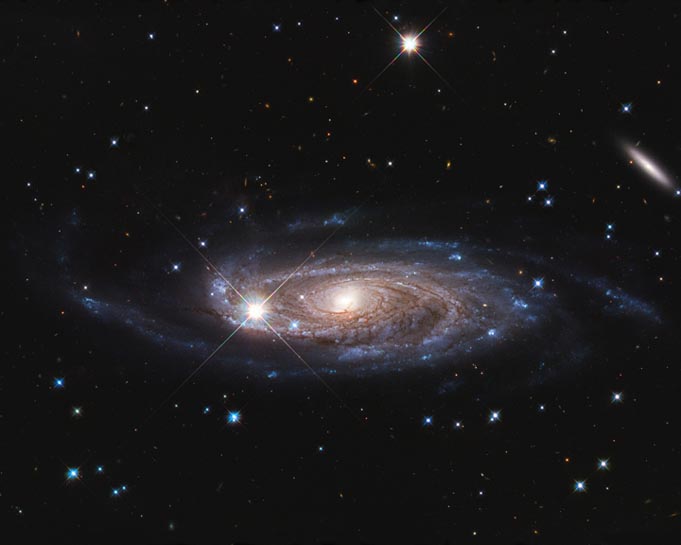
Spiral Galaxy
RA 03h 53m 02.46s Dec +35° 35' 22.17"
Perseus
232 million light years
13.5
5.5 x 2.5 arcmin
Dec 2017 - Jan 2019
Image is 5 arcmin across (about 338,000 light-years)
NASA, ESA & B. Holwerda (U of Louisville)
January 6, 2020
ABOUT
THIS IMAGE:
Summary:
Galaxies are like snowflakes. Though the universe contains innumerable galaxies flung across time and space, no two ever look alike. One of the most photogenic is the huge spiral galaxy UGC 2885, located 232 million light-years away in the northern constellation, Perseus. It's a whopper even by galactic standards. The galaxy is 2.5 times wider than our Milky Way and contains 10 times as many stars, about 1 trillion. This galaxy has lived a quiescent life by not colliding with other large galaxies. It has gradually bulked up on intergalactic hydrogen to make new stars at a slow and steady pace over many billions of years. The galaxy has been nicknamed "Rubin's galaxy," after astronomer Vera Rubin (1928 - 2016). Rubin used the galaxy to look for invisible dark matter. The galaxy is embedded inside a vast halo of dark matter. The amount of dark matter can be estimated by measuring its gravitational influence on the galaxy's rotation rate.
Hubble release:
To kick-start the 30th anniversary year of the NASA/ESA Hubble Space Telescope, Hubble has imaged a majestic spiral galaxy. Galaxy UGC 2885 may be the largest known in the local universe. It is 2.5 times wider than our Milky Way and contains 10 times as many stars.
Despite its gargantuan size, researchers are calling it a "gentle giant" because it looks as if it has been sitting quietly over billions of years, possibly sipping hydrogen from the filamentary structure of intergalactic space. This is fuelling modest ongoing star birth at a rate half that of our Milky Way. In fact, its supermassive central black hole is also a sleeping giant; because the galaxy does not appear to be feeding on much smaller satellite galaxies, it is starved of infalling gas.
A number of foreground stars in our Milky Way can be seen in the image, identified by their diffraction spikes. The brightest appears to sit on top of the galaxy's disc, though UGC 2885 is really 232 million light-years farther away. The giant galaxy is located in the northern constellation Perseus.The galaxy has also been nicknamed "Rubin's galaxy", after astronomer Vera Rubin (1928-2016), by Benne Holwerda of the University of Louisville, Kentucky, who observed the galaxy with the Hubble Space Telescope.
"My research was in large part inspired by Vera Rubin's work in 1980 on the size of this galaxy," said Holwerda. Rubin measured the galaxy's rotation, providing evidence for dark matter that makes up most of the galaxy's mass. "We consider this a commemorative image. The goal of citing Dr. Rubin in our observation was very much part of our original Hubble proposal."
Researchers are still seeking to understand what led to the galaxy's monstrous size. "It's as big as you can make a disk galaxy without hitting anything else in space," added Holwerda. One clue is that the galaxy is fairly isolated in space and doesn't have any nearby galaxies to crash into and disrupt the shape of its disc.
Did
the monster galaxy gobble up much smaller satellite galaxies over time?
Or did it just slowly accrete gas to make new stars? "It seems like
it's been puttering along, slowly growing," Holwerda said. Using
Hubble's exceptional resolution, his team is counting the number of globular
star clusters in the galaxy's halo - a vast shell of faint stars surrounding
the galaxy. An excess of clusters would yield evidence that they were
captured from smaller infalling galaxies over many billions of years.